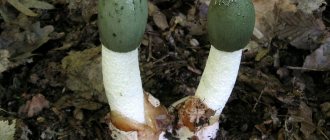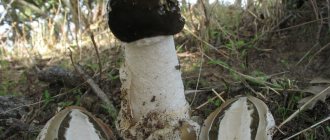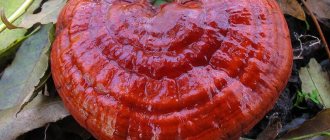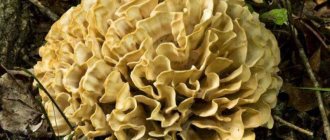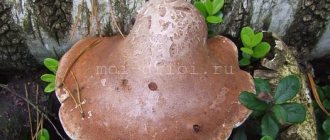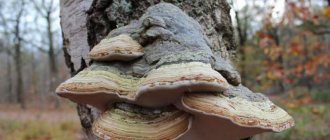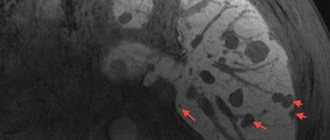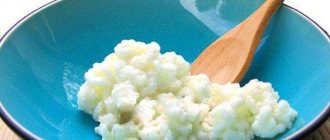Taxonomic history
This edible mushroom was described by Christian Hendrik Perun in 1796, when he named it Lycoperdon perlatum - still its accepted scientific name today. However, Lycoperdon perlatum has acquired several synonyms over the past few centuries.
When this mushroom was first described in scientific literature by Christian Hendrik Perun in 1796, it was given a specific definition that simply means “widespread.”
It could equally justify the alternative "vulgaris" as it is one of the most common fungi, especially in wooded habitats. At least 13 species of Lycoperdon occur in Britain.
External characteristics
What does a raincoat look like? Below is a more detailed description of hare potatoes.
Fruiting body. Typically pear-shaped and 3 to 6 cm in transverse diameter; from 4 to 9 cm in height. The surface, covered with tiny pearl drops, distinguishes the raincoat from many of its similar relatives.
Pyramidal warts or "pearls" come in varying sizes, are initially drained and then turned ocher before falling off to leave an olive-brown surface marked by faint scars where the warts used to be. The dark area at the top is the hole where the spores develop and through which they are released. The mushroom is unusually beautiful in old age. The outer predial spines fall away, leaving an exquisitely complex ocher and white meshwork on the inner surface. The base of the puffball is a more or less inverted cone, often somewhat distorted and containing a small amount of spongy, sterile material.
Controversy. Spherical, with thick walls - 3.5-4.5 microns in diameter. The spores are olive brown, dark brown when fully mature. In the spore sector there is a network of sometimes branched sterile yellowish-brown tubes (known as capillata – singular capillium) 3-7μm wide. Randomly distributed along the thick-walled capillia are pores formed by the narrowing of the walls. At maturity, a small hole opens in the upper part of the fruiting body. When the mature cap collapses, either from the impact of raindrops or the impact of animals, a smoky cloud containing spores is released.
Ecological role. Common puffballs are found in all types of forest, where they grow on the ground in the leaf litter; less often - on permanent pastures and on stable sand dunes. Most often found in small groups rather than alone, some individuals of the mushroom can sometimes branch like a desert cactus, but most are simple pear-shaped fruiting bodies. Season: The mushroom can be found from July to November.
Similar types. Lycoperdon echinatum is darker, has a reddish tint and is covered in spines. Lycoperdon mammiforme will be white at first, and then its surface will break up into large, cream-colored scales rather than pearly warts.
Edible species
There are more than 50 types of raincoats. Among them there are edible, conditionally edible (suitable for consumption only after careful heat treatment) and inedible (they do not contain poison, but they are poorly absorbed by the human body or are unpleasant to the taste). The most common edible species are pear-shaped, black-spined, yellow-colored, ragged, and spiny.
Pear-shaped puffball (Lycoperdon pyriforme)
On the soil it looks like a ball, since the pseudopod is short and often does not show on the surface. The fruiting body has a diameter of 3-7 cm, the height of the entire mushroom is no more than 4 cm. The young puffball has a white skin and cotton-like pulp. As they mature, the skin and “filling” darken, becoming red or brown. Upon contact with an adult puffball, the surface cracks like an eggshell, releasing brown spores. Only young mushrooms with light flesh when cut are suitable for food. It grows in large crowded groups in moist deciduous and coniferous forests of any country. It is found everywhere in Russia. Most often, flutter can be found on rotting wood (for example, on rotten stumps).
Pear-shaped puffball (Lycoperdon pyriforme)
Black-thorned puffball (Lycoperdon echinatum)
People also call this raincoat spiky or hedgehog. It has a pear shape. A characteristic feature is the spines pressed closely together, covering the entire surface of the mushroom. These needles are not sharp and easily fall off with a touch to the puffball, exposing the smooth skin. Young mushrooms have white flesh; in adults it turns green or brown. A cavity with dark spores forms in the center of the old puffball. This mushroom grows singly or in small scattered groups. Mainly found in heather heaths and deciduous forests. It can also be found on calcareous soils. In Russia, it is most widespread in the European part, in the forests located along the Volga, Dnieper and Don.
Black-prickly raincoat
Yellow-colored puffball (Lycoperdon flavotinctum)
A round mushroom with a large fruiting body and a stalk less than 1 cm in length. The surface is beige or yellow (the younger the mushroom, the brighter it is), rough. When the spores mature, the outer shell cracks like an egg peel, revealing a circular cavity filled with dark dust from the spores.
When cut, young porcini mushrooms have clear longitudinal fibers - only such specimens are suitable for cooking.
With age, the mushroom darkens from the inside and becomes rancid in taste. It does not bear fruit every year. Distributed in Eastern Europe and North America. For Russia, a yellow-colored raincoat is a rarity. Infrequently, mushroom pickers find it in the deciduous forests of Moscow, Rostov, Kaluga and other regions of the European part of the country.
Yellow-colored puffball (Lycoperdon flavotinctum)
Puffball (Lycoperdon velatum)
The mushroom is 3 to 6 cm high. It has a clearly defined short stalk and a wide upper part. The surface is uneven, as if torn, which is why it got the name “ragged”. The color of the shell can be white in young specimens, but with age it becomes reddish-brown. The pulp also gradually darkens - from milky to chocolate. Only light cut mushrooms are suitable for food. Grows in small groups in oak and oak-hornbeam forests. Found in Belarus, Ukraine, Europe, Southeast Asia and North America. In Russia, the largest populations are in the Central and Central Black Earth parts, as well as in the North Caucasus region.
Puffball (Lycoperdon velatum)
Meadow puffball (Vascellum pretense)
It has a rounded fruit body, tapering downward. Diameter – 3–6 cm. The surface of young mushrooms is white, of adults – olive or yellow, of old ones – red or brown. When cut, the fruiting body will also be different: young puffballs have white pulp, similar to cotton wool; mature ones – gray or brown. Only the light-colored mushroom is edible; when it darkens, it becomes bitter. This type of raincoat grows in open areas with a large amount of humus in the soil - mainly in meadows and pastures. Found throughout Russia.
Meadow puffball (Vascellum pretense)
Puffball (Lycoperdon perlatum)
Other names for this mushroom are real or edible puffball. It has a pear-shaped shape - a round top, smoothly turning into a thick leg. The fruit body is no more than 2 cm in diameter. Height is from 2 to 8 cm. There are small spines on the surface, which disappear as the mushroom matures. The age of a raincoat can be determined by the shade of its skin - the lighter the specimen, the younger it is.
Brown and dark gray mushrooms contain voids with spores inside and are not suitable for food. It is a common mushroom that can be found in all countries with coniferous and deciduous forests. Most of these raincoats are in Northern Europe, southern India, Northern Australia, New Zealand, and China. You should look for the mushroom on rotting wood and manured soil in the shade under trees. In Russia, the mushroom is often found in the forests of the Moscow, Leningrad, Rostov regions and the Krasnodar Territory.
Puffball (Lycoperdon perlatum)
Giant puffball (Lycoperdon giganteum)
Another name is Giant bighead. The fruiting body has the shape of a ball or egg with a smooth surface. At the base there is a thick root-like cord. Only young specimens with thick snow-white skin and light flesh when cut are edible. If the surface of the mushroom turns dark yellow, green or brown, it means it is ripe and should not be eaten due to its strong bitterness. The mushroom grows mainly in mixed and deciduous forests. Loves warmth and moisture. In Russia, most of these raincoats are in Karelia, the Far East, Siberia and the Krasnoyarsk Territory.
Giant puffball (Lycoperdon giganteum)
Umber raincoat
The brown or umber raincoat got its name from the color of the surface of the body. It grows practically “sitting” on the ground, because its “leg” is very short. This species is small in size: its diameter is no more than 5 cm. On top it is covered with dark brown peculiar spines, with which it is almost impossible to damage your skin. This raincoat can be easily identified by the patterned patterns that the needles form. Often these patterns resemble the shape of a star. The brown puffball is edible and is readily used in cooking to prepare aromatic and savory dishes. Its flesh is white; in young specimens it darkens to a purple-brown color with age.
Umber raincoat
Beneficial features
One can talk endlessly about the beneficial properties of the seemingly inconspicuous puffball, and although mushroom pickers know incredibly little about it and constantly wonder whether it is edible or not, it is quite well known to doctors, as it has incredible healing properties.
Hare potatoes are capable of absorbing heavy metals, radioactive substances, toxins and other substances that can harm the body or provoke the development of cancer.
This plant is capable of removing from the body excess chloride and fluorine compounds, radionuclides, which negatively affect the functioning of the thyroid gland.
Use in cooking
Is the puffball mushroom edible? The puffball mushroom is eaten, but only young individuals are used in cooking, until the period when the pulp is juicy and fleshy and spores have not formed in the cap. How to cook? They are mostly dried, but mushroom pickers still prefer to boil or fry with the addition of spices, onions and carrots.
Are mushrooms eaten raw or simply pickled? No. The mushroom does not have a special smell or taste. It is important to thoroughly heat treat the raincoat in order to eliminate the possibility of poisoning.
Young mushrooms need to be cleaned and washed thoroughly. Chop into convenient pieces and fry with spices, onions and other vegetables; mushrooms are often combined with sour cream and garlic. You can experience all the charm of raincoat in stewed and grilled form. Their pulp behaves excellently during heat treatment, has a delicate and light taste and practically does not lose volume during cooking.
Can adults be eaten? It is highly not recommended to eat old mushrooms with ripened spores.
Benefits and treatment
It is worth noting the huge number of useful properties of this product. If you eat it regularly, the body is actively cleansed of toxins that adversely affect the condition of the kidneys, liver and other vital organs.
Mushrooms free the body from radionuclides and heavy metals, preventing the formation and development of cancer cells.
Also, dishes with the addition of hare potatoes have a positive effect on the functioning of the thyroid gland and stimulate the full functioning of the cardiovascular system.
Very often, this mushroom is also used in cosmetology: raincoats are added to masks and creams to obtain elastic, smooth, firm and taut skin. With regular use, the skin color becomes healthier, more uniform, without greasy shine and at the same time with significantly reduced pores. This effect occurs due to the rapid cleansing of toxins from the body.
In ancient times, doctors and healers used mushroom broth to treat various ailments, correctly assessing the comprehensive benefits of the product.
Red fly agaric
For centuries it has been used throughout Russia in folk medicine as a powerful medicinal mushroom. Preparations from fly agaric and its medical use are legal in many developed countries, including the USA, Canada, Great Britain, Denmark, Norway, the Netherlands, Italy, Japan and others.
Photo: From personal archive/ Mikhail Vishnevsky
Special recipe : rubbing agent for radiculitis or rheumatism. Place cut red fly agaric mushrooms in a plastic bag and keep in the refrigerator for 2 days. Cut into pieces, put in a jar and pour vodka so that it covers the mushrooms with a layer as thick as a finger. Seal, refrigerate or cellar for 2 weeks, then strain. Rub on sore areas to relieve pain. Practitioners claim that the product, when used regularly, can cure radiculitis.
Why are mushrooms collected along roads dangerous? →
Harm and contraindications
This product does not cause harm to the body and does not have toxic analogues. But still, how to distinguish it from a poisonous mushroom? Before consumption or use for cosmetic or medicinal purposes, you need to remember that these are the most healthy and tasty young mushrooms with white, tender and dense flesh. But it is also important to consider their place of collection and growth: they perfectly absorb all nutrients and harmful substances from the soil. It is strictly prohibited to collect them near the road and in industrial zones.
The product is not allowed for use by children and adolescents, women during lactation and pregnancy, people in very old age, with gastrointestinal diseases (very difficult to digest).
Contraindications
To use mushrooms for food or for medicinal purposes, it is prohibited to collect them along busy highways and in areas with unfavorable ecological conditions, as this is fraught with poisoning.
Contraindications for use are also:
- pregnancy;
- lactation;
- childhood;
- individual intolerance;
- renal failure.
It is recommended to start treatment with minimal doses and, if there are no negative manifestations, continue taking it at the indicated dosages.
I told you about the special properties of raincoats, their benefits and harms for the human body. Have you ever seen such mushrooms? Have you used them for cooking or medicine? Write about your results of use.
Subspecies
The raincoat mushroom has many subspecies, among which I would like to note the main ones:
- spiny – meadow and forest habitat; a characteristic difference is a tubercle in the upper part of the cap, a white mushroom with small spines;
- giant – an important difference is the huge size with a white or yellow-gray color; the maximum weight of the mushroom in adulthood is recorded at 7 kilograms;
- bighead - another false species of raincoat, has a round shape, up to 15 centimeters high, first white, and then yellowish and brown in color;
- oblong - similar to the bighead, only the shape is club-shaped.
Description of the Puffball Mushroom
The raincoat mushroom can be found in a wide variety of places - it is not picky about the soil and grows where there are open spaces: in clearings in deciduous and coniferous forests, in fields, meadows and parks, in pastures. Sometimes they can be found in groups or semi-circles, and some can stand at a great distance from each other. Giant puffball mushrooms rarely grow twice in the same place, but sometimes it happens that during the season, which lasts from late May to early November, they produce several harvests.
Dust moths feed on decaying organic debris and reproduce by spores. They are considered a close relative of champignons, but are not very similar in appearance. They have many subspecies, but the main ones are:
- Spiny - represents a whole body, without the characteristic legs and cap. Its entire surface is covered with thorns that easily fall off when touched, and in the middle there is a characteristic tubercle. Most often they grow in groups.
- Oblong - has an oblong large club-shaped body, with a thickening in the upper part. It can reach 7-15 cm in height.
- Giant – has the shape of a ball or egg, and is slightly flattened. The size is large: from 20 to 50 cm in diameter, and the weight varies from 8 to 20 kg.
All types of dust pollen listed are shown in the photo:
Many people wonder: is the puffball mushroom edible or not? All described species are edible at a young age: while the flesh is white and has a dense structure. When the color of the pulp changes to yellow or brown and it becomes powdery, it can no longer be eaten. The elastic white young pulp is not only edible, but also very tasty and healthy.
Before you cook the puffball mushroom, you need to remove the top shell from it, because it is very rough, but otherwise they are prepared like regular types: fried, stewed, boiled, dried and canned. The pulp can be fried with onions or like a steak, pre-breaded in breadcrumbs or batter. Boiled fresh puffballs absorb too much water (like a sponge), so many people prefer to fry them. To use for medicinal purposes, they are dried, ground into powder and stored in a tightly closed glass container.
Giant puffball mushroom in medicine
The giant puffball mushroom belongs to the puffball family, often called giant puffball or langermania. Langermanium powder is actively used in medicine and veterinary medicine.
Preparation of a tincture used for the treatment of viral, inflammatory and other diseases, as well as for the treatment and healing of various skin diseases and wounds.
How to prepare the correct infusion?
First recipe: take 1 dessert spoon of mushroom powder, pour 1 glass of water at a minimum temperature of 70 degrees. The tincture should be kept in a glass container or thermos for at least 40 minutes, and consumed half a glass of the infusion 2 times a day before meals.
Second method of preparation: for preparation you need to take vodka and powder in proportions of 1:5. The spores must be infused for 2 weeks in a warm and dark place. The resulting tincture should be consumed 1-2 teaspoons 3-4 times a day before eating. The duration of therapy is from 3 to 4 weeks, after which you must take a 7-day break and, if necessary, repeat the course.
For the treatment of cancer: spore powder in a volume of 1 glass is poured into 0.5 liters of vodka, rolled into a jar and buried in the ground to a depth of 30 centimeters. Preparation lasts 3 weeks. Then you need to dig out the jar and carefully, without shaking, strain. The tincture is taken 1 tablespoon 3 times a day before meals.
Best materials of the month
- Coronaviruses: SARS-CoV-2 (COVID-19)
- Antibiotics for the prevention and treatment of COVID-19: how effective are they?
- The most common "office" diseases
- Does vodka kill coronavirus?
- How to stay alive on our roads?
In order to remove kidney stones, eat regular bread sprinkled with spore powder 3 times a day. To obtain spore powder, only fully mature specimens are collected.
